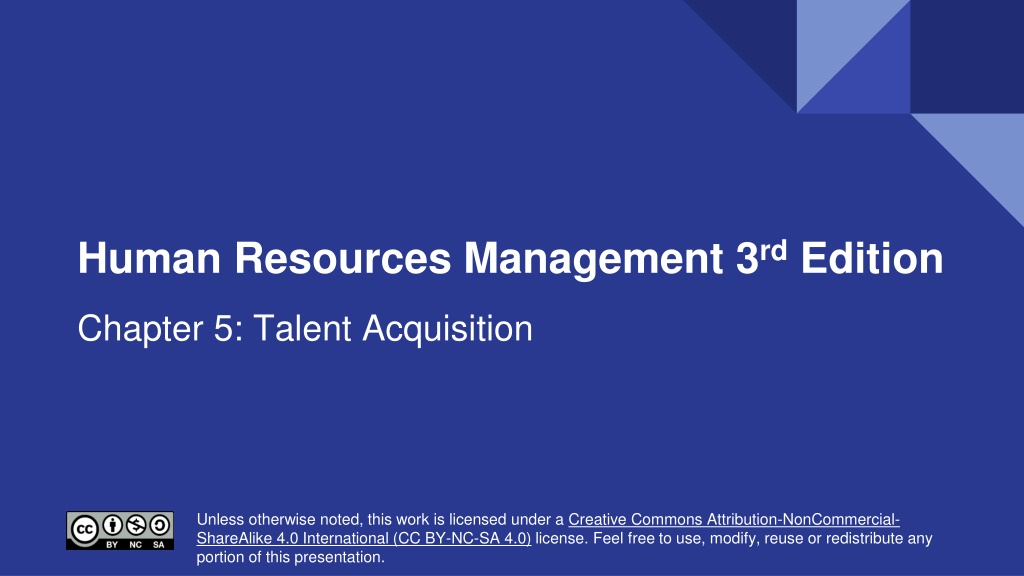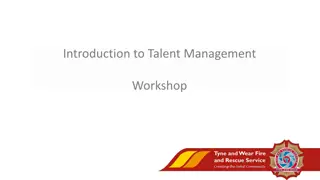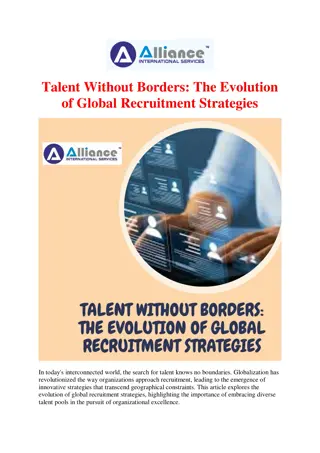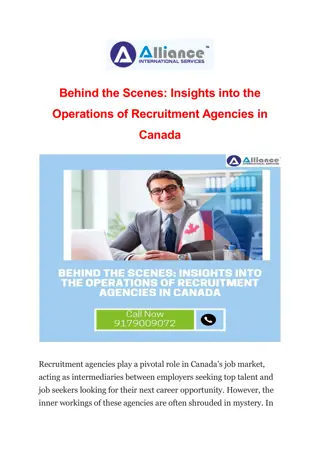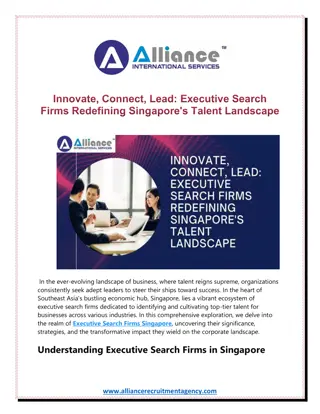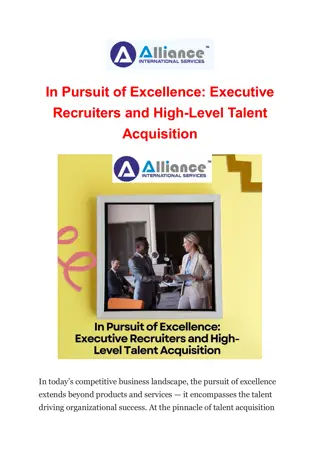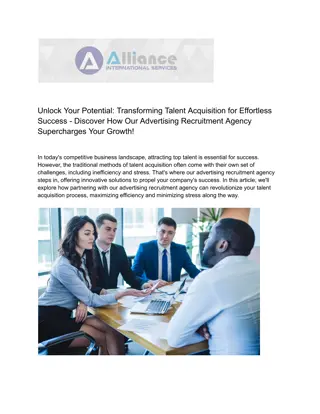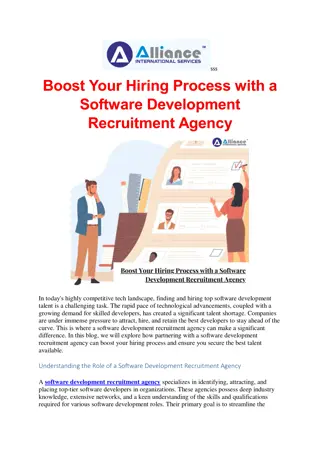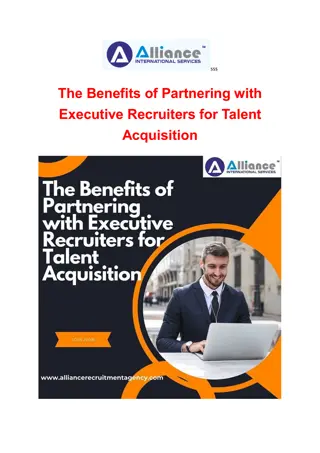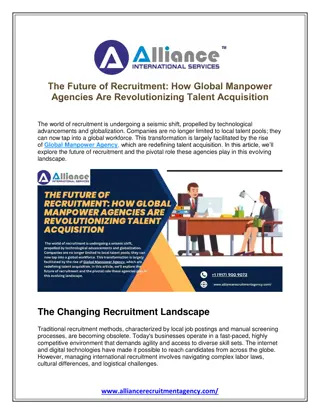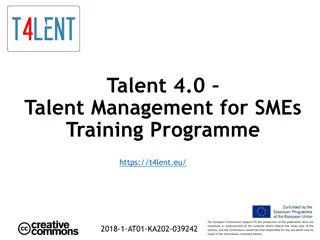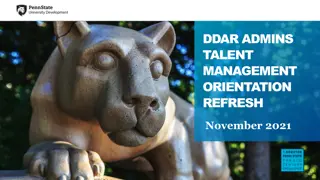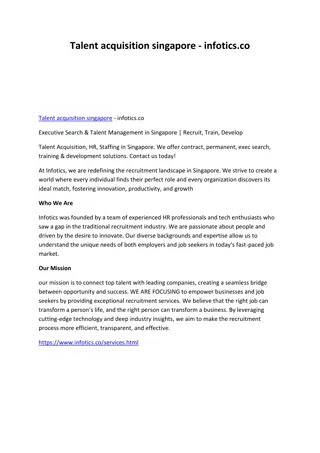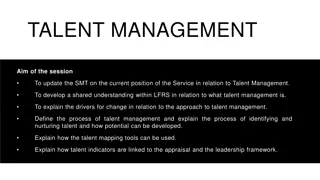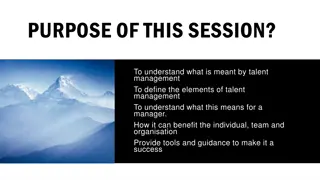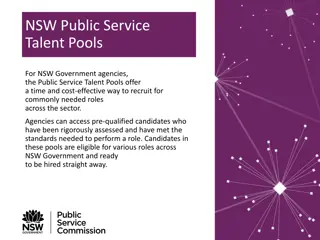Efficient Talent Acquisition Strategies in Human Resources Management
Recruitment processes are crucial in acquiring qualified job candidates while considering factors like talent diversity. Organizations benefit from strategic recruitment planning, trend analysis, and proactive tracking to ensure efficiency and effectiveness in selecting the right employees for sustainable success.
Download Presentation

Please find below an Image/Link to download the presentation.
The content on the website is provided AS IS for your information and personal use only. It may not be sold, licensed, or shared on other websites without obtaining consent from the author. Download presentation by click this link. If you encounter any issues during the download, it is possible that the publisher has removed the file from their server.
E N D
Presentation Transcript
Human Resources Management 3rdEdition Chapter 5: Talent Acquisition Unless otherwise noted, this work is licensed under a Creative Commons Attribution-NonCommercial- ShareAlike 4.0 International (CC BY-NC-SA 4.0) license. Feel free to use, modify, reuse or redistribute any portion of this presentation.
Learning Outcomes 1. 2. 3. 4. 5. 6. 7. 8. 9. 10. Explain the types of tests that can be administered as part of the selection process. 11. Discuss the types of selection models and errors in selection. Discuss the need and techniques for forecasting human resource needs. Explain the steps to an effective recruitment strategy. Develop a job analysis and job description. Explain the various strategies that can be used in recruitment. Name and discuss the steps in the selection process. Explain why criteria development is an important part of the selection process. Apply examples of the types of criteria that can be developed. Describe the advantages and disadvantages of internal and external candidates. Explain the various types of interviews and interview questions.
5.1 The Recruitment Process Recruitment is defined as a process that provides the organization with a pool of qualified job candidates from which to choose. Highly talented and motivated employees offers a competitive advantage which is a firm s ability to add value to the company through it s assets (one being its human resources); and is able to lower its costs. Photo by Clem Onojeghuo, Unsplash License
5.1 The Recruitment Process Recruiting the right employees, including a diverse range of candidates, is crucial for an organization's success and provides a competitive advantage. HR Capital Plan Evaluate goals of Organization Identify factors that might affect the staffing plan Establish current talent landscape Conduct trend analysis to help forecast needs Conduct a gap analysis Develop the recruitment plan
5.1 The Recruitment Process Trend analysis predicts future staffing needs by analyzing past employment and business variables. Recruitment planning requires proactive tracking of pipelines to ensure an efficient process. Yield ratio measures recruitment method efficiency and informs future investments. The Recruitment Process by Fanshawe College CC-BY based on content from Bika (n.d.).
5.2 Recruitment Plan Internal & External Consider internal, external, or both sourcing options for a recruitment plan, each with implications for recruiting. Internal Recruitment Internal Job Postings External Recruitment Networking/Referrals Professional Associations Websites/Online Job Postings/Social Media Campus Recruiting Events/Career Fairs
5.3 The Law and Recruitment and Selection The process of specifying the desired knowledge, skills, abilities, others (KSAO s) implicitly can exclude potential applicants. HR departments must follow the law. Wages, working conditions, diversity, employment equity, labour relations and human rights are all intertwined in recruitment and selection of employees. Employment Standards Act Pay Equity Act Labour Relations Act Human Rights Code Health and Safety Act
5.4 Application Forms Resumes & Application forms are used to determine a suitable applicant. Job Application Information Personal Information Employment Status Education Work History References Other Information Applicant Signature
5.5 Recruitment Strategies Recruiting is like marketing and aims to generate quality job applications. HR should manage the public image of companies on social media platforms like LinkedIn and Glassdoor. Professional Recruiters Job Websites Social Media Campus Recruiting and Events Professional Associations Referrals
5.7 The Selection Process The selection process chooses candidates who have the right qualifications for the job. While managers have the final decision, HRM guides and assists them. Step Two: Step One: Step Four: Step Six: Step Three: Step Five: Application and resume review Criteria development Making the offer Test Interviewing Selection administration
5.8 Criteria for Interviews HR managers should determine which qualifications are required for the position and how they will be assessed. This can be informed by the job analysis and job specifications. HR managers should sequence the assessment of KSAOs based on cost. Some other considerations are: validity and reliability of methods, and organizational fit (see next slide).
5.8 Criteria for Interviews Validity and Reliability Validity: whether a test measures what it claims to measure Reliability: whether an assessment instrument gives consistent or dependable results Organizational Fit Fit includes technical expertise, education, experience, company culture, and team culture Criteria that go beyond the specific elements of the job, such as willingness to take risks or focus on developing leaders.
5.9 Application and Resume-Review The resume is the key document in the selection process. The hiring organizations may also require an application to be completed in addition to the resume. Used to screen candidates for further steps in application process. Resume options can vary by industry or type of job sought. Typical resumes often include the following information: Education Work experience Qualifications and skill sets
5.10 Interview Bias Confirmation Bias Interviews can be biased, but HRM advances offer solutions to improve reliability and validity. Similar-to-me Bias Anchoring Bias Interview Bias Interviewer Domination Stereotyping Leading Questions Halo Effect
5.11 Interview Structures Unstructured interviews Improvised by interviewer, no plan or standard questions, unreliable/biased decisions, hiring mistakes. Structured interviews Standardized questions based on job analysis, fair and reliable comparisons between candidates, up to twice as effective at predicting job performance, better hiring decisions.
5.11 Types of Structured Questions Situational Questions: Evaluate applicant's cognitive ability related to the job by focusing on job-specific situations that test their judgment. Behavioural Questions: Evaluate past work experiences to predict future performance. Personality Based Questions: Ask about the applicant s interests, hobbies, and passions to align them with the job.
5.12 Interview Types Most organizations conduct multiple interviews using various interview types, depending on the job. Traditional Telephone/Video Panel Group Company tour/meal This Photo by Women in Tech is licensed under CC BY
5.13 Test Administration Standardized testing can complement interviews, providing objective and inexpensive assessments. Psychological Test (Aptitude, Personality) (soft skills) Physical Ability Tests Job Knowledge Tests (hard skills) Work Sample
5.13 Final Steps in Test Administration Reference checks Verify a candidate s employment background. Written consent must be sought. Criminal Checks May be required for those working with vulnerable populations. Written consent must be sought. Social Media Checks 70% of employers screen candidates on Facebook, Twitter, LinkedIn etc.
5.14 Combining The Test Results Information HR managers have access to various tools, data sources, and tests to aid in selecting new employees, and multiple tools may need to be combined to make a final decision. Clinical Approach Reviewing all the data and making a decision. Statistical Approach Not all aspects of selection are weighted equally. Compensatory Approach Multiple Cutoff Approach Multiple Hurdle Approach
5.15 Selection Offers and Errors Offer details such as compensation, start date, incentives, and legal agreements are confirmed, along with a timeframe for acceptance. Efficient and positive offer process. Set expectations and negotiate earlier to avoid misunderstandings. Errors in assessment and selection of candidates do happen. Type I: When a selected candidate turns out to be a poor performer. Type II: When a process fails to detect a potentially good performer.
Learning Outcomes Discuss the need and techniques for forecasting human resource needs. Explain the steps to an effective recruitment strategy. Develop a job analysis and job description. Explain the various strategies that can be used in recruitment. Name and discuss the steps in the selection process. Explain why criteria development is an important part of the selection process. Apply examples of the types of criteria that can be developed. Describe the advantages and disadvantages of internal and external candidates. Explain the various types of interviews and interview questions. Explain the types of tests that can be administered as part of the selection process. Discuss the types of selection models and errors in selection.
End Chapter Review What should be included in a recruitment plan? How can campus recruiting be effective for entry-level positions? What are some methods for reducing recruitment costs and evaluating recruitment experience? What factors should be considered when assessing the cost- effectiveness and experience of a company's recruitment efforts?
